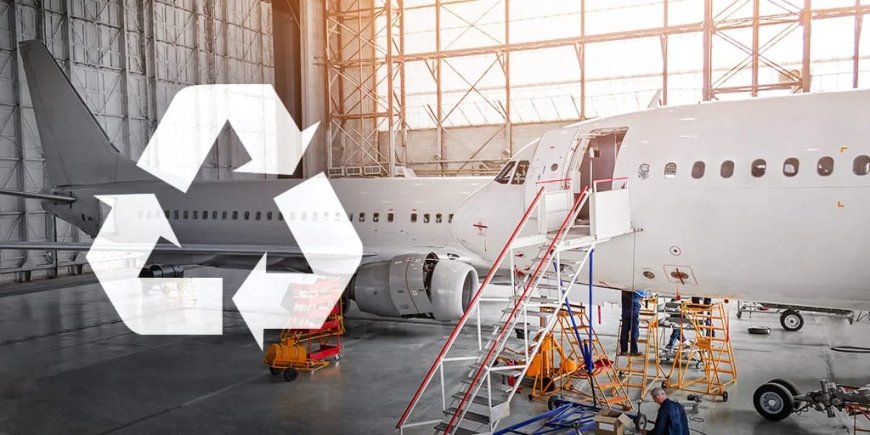Aircraft Recycling Industry Forecast: Market to Hit USD 11.28 by 2030, Growing at 8.59% CAGR
The global aircraft recycling market was valued at USD 5.35 billion in 2022 and is expected to reach USD 11.28 billion in 2030, with a CAGR of 8.59% during the forecast period 2023-2030.

Infinium Global Research dives deep into the aircraft recycling market with a comprehensive report analyzing global and regional segments and sub-segments. This analysis extends beyond just market size (presented in dollar values) to explore the impact of short-term and long-term drivers, restraints, and even macroeconomic factors influencing the market. The report offers valuable insights into current trends, future forecasts, and the overall health of the global aircraft recycling market.
Get Sample Pages of Report: https://www.infiniumglobalresearch.com/form/?name=Sample&id=402
Stringent environmental regulations are acting as a tailwind for the aircraft recycling market. Regulatory bodies are implementing stricter rules on how airplanes are decommissioned and disposed of, ensuring eco-friendly practices. This not only compels companies to comply legally but also presents a strategic opportunity. By embracing sustainable practices, aviation companies can improve their corporate social responsibility image and gain a competitive edge. Furthermore, the growing concept of a circular economy is fueling market growth. Stakeholders are recognizing the economic potential of recycling aircraft parts. Salvaging and reusing components and materials from retired airplanes not only reduces waste but also promotes resource efficiency. This translates to a lesser dependence on virgin materials, minimizing the environmental impact associated with their extraction and production. In essence, both stricter regulations and the shift towards a circular economy are creating a perfect storm for the growth of the aircraft recycling market.
Market Dynamics
Driver:
· Regulatory Push for Sustainability: Stringent environmental regulations are mandating eco-friendly aircraft decommissioning practices. This not only compels compliance but also presents a strategic advantage for airlines seeking to boost their sustainability credentials.
· Circular Economy Takes Flight: The concept of a circular economy is gaining traction within the aviation industry. Stakeholders are recognizing the economic and environmental benefits of recycling aircraft materials and parts. Salvaging and reusing these components minimizes waste, reduces reliance on virgin materials, and lowers the environmental impact of resource extraction and production.
· Surge in Retired Aircraft: As the global fleet ages, a growing number of airplanes reach the end of their operational lives. This rising number of retired aircraft fuels the demand for efficient and responsible recycling services.
· Economic Viability: Aircraft recycling offers economic benefits through material and parts recovery. Valuable metals like aluminum, titanium, and steel can be recycled, while many airlines utilize recovered parts for cost-effective maintenance. This economic viability incentivizes further market growth.
Challenges and Opportunities
· High Upfront Investment: Establishing a dedicated aircraft recycling facility and acquiring the necessary equipment requires significant initial investment. This can be a hurdle for new entrants into the market.
Market Segmentation
Aircraft Type: This segment categorizes the market based on the type of aircraft being recycled. The sub-markets include:
· Narrow-body: These are the most common aircraft type retired, due to their shorter lifespans and high production volumes.
· Wide-body: Larger aircraft with a higher material content, offering significant potential for material recovery.
· Regional Jets: These smaller aircraft contribute to the overall market growth.
Product: This segment focuses on the different components and parts recovered from retired aircraft. The sub-markets include:
· Engine Components: Valuable and complex parts that can be refurbished or recycled for their materials.
· Landing Gear: Durable components with reusability potential after proper inspection and maintenance.
· Avionics: Technological advancements may require specialized recycling processes for certain avionics components.
· Other Products: This category includes various interior components, auxiliary equipment, and other recyclable materials.
Material: This segment identifies the materials retrieved during the aircraft recycling process. The sub-markets include:
· Aluminum: The most commonly used material in aircraft construction, offering high recyclability and economic value.
· Other Metals & Alloys: This category includes titanium, steel, and other metals used in various aircraft parts, each with its own recycling processes.
Regional Analysis
· North America (Dominant Player): This region holds the top spot in the aircraft recycling market, driven by several factors. It boasts one of the world's largest and most established aviation industries, with numerous airlines, manufacturers, and MRO facilities. This translates to a high volume of aircraft reaching retirement age, creating a consistent feedstock for recycling companies. Furthermore, North America's well-developed infrastructure facilitates efficient aircraft transportation and dismantling processes.
· Europe (Championing Sustainability): Europe is expected to capture a significant market share due to its strong focus on environmental regulations. The continent has been a leader in implementing stringent environmental policies and promoting sustainable aviation practices. These regulations compel airlines and operators to adopt eco-friendly aircraft decommissioning methods, driving demand for responsible recycling services.
· Asia Pacific (Emerging Market): The Asia Pacific region represents a promising emerging market for aircraft recycling. With a rapidly growing aviation industry, this region is expected to witness a surge in aircraft retirements in the coming years. However, the current market size is smaller compared to North America and Europe. As regulations evolve and infrastructure develops in the region, the Asia Pacific market is anticipated to experience significant growth.
· Rest of the World: Other regions around the globe are also expected to contribute to the overall market growth, albeit at a slower pace compared to the leaders. As environmental awareness and regulations increase worldwide, the demand for responsible aircraft recycling is expected to rise in these regions as well.
Report overview: https://www.infiniumglobalresearch.com/market-reports/global-aircraft-recycling-market
Competitive Landscape
· Aircraft End-of-Life Solutions (AELS)
· TARMAC AEROSAVE
· ecube,inc
· AIR SALVAGE INTERNATIONAL LTD
· Aviation International Recycling
· Vallair
· VIRTUSTRADE RECYCLING AIRPLANES
· ComAv - Commercial Aviation Services
· VAS Aero Services, LLC
· CAVU Aerospace Inc.
Future outlook
In-depth analysis of upcoming trends that will influence market demand throughout the 2023-2030 forecast period. Insights derived from analytical tools like Porter's Five Forces and DRO analysis to assess the competitive landscape and identify potential opportunities or threats. Investment area identification for both established and new players through the IGR-Growth Matrix analysis, guiding strategic decision-making. Regional breakdowns highlighting the competitive landscape and market share of leading players, allowing for a targeted approach.
Conclusion
The Infinium Global Research report provides a comprehensive analysis of the aircraft recycling market, looking beyond just market size (valued at USD 5.35 billion in 2022 and expected to reach USD 11.28 billion in 2030 at a CAGR of 8.59%) to explore the underlying factors impacting its growth. Key drivers include stricter environmental regulations pushing for sustainable decommissioning practices, the rise of the circular economy promoting resource efficiency through parts and material reuse, and a growing number of retired aircraft feeding the demand for recycling services. Economic viability through material and parts recovery further incentivizes market growth.
Contact Us:
Infinium Global Research LLP
Mob: +91 9923950043
Email: info@infiniumglobalresearch.com
What's Your Reaction?
 Like
0
Like
0
 Dislike
0
Dislike
0
 Love
0
Love
0
 Funny
0
Funny
0
 Angry
0
Angry
0
 Sad
0
Sad
0
 Wow
0
Wow
0



















































